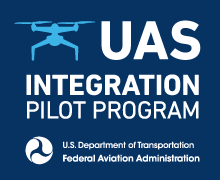Podcast: Play in new window | Download (Duration: 30:36 — 21.1MB)
Additional details of the FAA UAS Integration Pilot Program have emerged, with webinars held on that topic by the FAA and others. Also, Boeing’s acquisition of Aurora Flight Sciences is complete, NASA’s Aeronautics Research Mission Directorate (ARMD) is expanding its research scope to include Urban Air Mobility, and drone strikes on manned aircraft.
UAV News
UAS Integration Pilot Program Webinar
The FAA conducted several one-hour UAS Integration Pilot Program webinar sessions. The Program seeks to achieve BVLOS and other complex operations (flight at night, over people, and operational coordination with manned aircraft), promote innovation, develop regulations that reduce the need for operations by exception. address security concerns, and balance national and local interests.
The 17-minute UAS Integration Pilot Program Webinar video provided an overview of the program, the application process, acceptance criteria, and deadlines.
We recorded the live Q&A session from the November 3, 2017, webinar, which runs about 40 minutes:
To learn more, about the UAS Integration Pilot Program, see these FAA webpages:
UAS Webinar: Regulatory and Policy Developments
Hogan Lovells Unmanned Aircraft Systems is offering a free webinar Thursday, November 16, 2017, 2:00 p.m. – 3:30 p.m. Eastern to discuss key UAS regulatory and policy developments and provide insight on the Part 107 waiver process. Emily Avant, Senior Counsel for CNN, will be participating to discuss CNN’s new waiver for operations over people, what it means for the broader commercial UAS industry, and tips for making your waiver application a success.
Other webinar topics will include:
- Status update on Part 107 waivers granted to date
- The inside scoop on CNN’s precedent-setting waiver for operations over people
- Developing a safety case for a Part 107 waiver application
- The Trump Administration’s new UAS Integration Pilot Program
- Rollout of the FAA’s Low Altitude Authorization and Notification Capability (LAANC) system
- Upcoming FAA rulemakings and next steps moving forward
Register for the Hogan Lovells webinar here.
Also, Drones and the Legal Landscape from the AOPA Drone Talk Series will be held November 10, 2017, 8 PM Eastern.
Boeing completes acquisition of Aurora Flight Sciences
Boeing announced the completion of its acquisition of Aurora Flight Sciences. Aurora will operate under Boeing Engineering, Test & Technology as a subsidiary called Aurora Flight Sciences, A Boeing Company. It retains its independent operating model. Boeing first announced the agreement with Aurora on Oct. 5, 2017, pending U.S. government approval.
NASA Embraces Urban Air Mobility (UAM), Calls for Market Study
NASA’s Aeronautics Research Mission Directorate (ARMD) is expanding its research scope to include Urban Air Mobility or UAM.
UAM is defined in this article as “a safe and efficient system for air passenger and cargo transportation within an urban area, inclusive of small package delivery and other urban Unmanned Aerial Systems (UAS) services, which supports a mix of onboard/ground-piloted and increasingly autonomous operations.”
NASA’s associate administrator for aeronautics Jaiwon Shin says, “We plan to conduct the research and development, and test the concepts and technologies that establish feasibility and help set the requirements. Those requirements then serve to make using autonomous vehicles, electric propulsion, and high density airspace operations in the urban environment safe, efficient and economically viable.”
ARMD awarded contracts to Booz Allen Hamilton and to Crown Consulting to conduct market studies on the policy, economic, social, environmental, and legal barriers to enabling UAM; and also to estimate how much potential demand there is for UAM.
Here’s How Drones Do (and Don’t) Threaten Passenger Aircraft
Recently, a civilian drone struck a U.S. Army UH-60M Blackhawk helicopter and a drone hit a Beechcraft King Air. Studies have been conducted by the Crashworthiness for Aerospace Structures and Hybrids (CRASH) Lab, the U.K.’s Department for Transport and Military Aviation Authority, and George Mason University, but there is little data on the damage small drones can cause in a collision.

